Sangita Kalacharya Vidvan Shri S
Rajam is a many splendored jewel of Indian art and music. He is the musicians’
musician, held in very high esteem by the connoisseurs of Carnatic music;
he is the creator of sublime art in the pristine and ancient tradition
of Chitrasutra; he is an excellent photographer who produced outstanding
photographs of temple architecture and sculptures; and in his youth a hero
of early South Indian films who composed songs and sung them too. The most
amazing aspect of his involvement in several branches of arts is that he
excelled in each of them, created a unique niche of his own and yet remained
unaffected by his success. And, above all he is a remarkable human being
with a flame-like imagination and a teacher with an understanding heart.
He is often, aptly, described as a simple man of singular achievements
in a plurality of fields. It is hard to cite anyone, in the contemporary
world, as comparable to Shri S Rajam. He is a rare gem; and like any precious
gem he is away from public gaze.
Even as he is mellowing sweetly into
his nineties, he retains the sense of wonder and awe at the marvels of
life. He continues to work with zeal, regularly, at his art; and says with
a child-like delight he is discovering and learning a few new things each
day. As regards music, his other passion in life, he is still active in
it as a teacher and as a guide; and he continues to participate in academia
and in the discussions at various Sabhas
I have special regard, appreciation
and reverence towards Shri S Rajam, because I view him as one of the few
gifted artists of the twentieth century who breathed fresh life into the
ancient tradition of Chitrasutra, not by talking or writing about the ancient
art but by diligently practicing it with devotion and sincerity over a
long period of more than sixty years. My admiration of him is heightened
because he is perhaps the sole true representative and votary of the Chitrasutra
in the modern era. To use a favorite phrase of Sri Sankara, Shri S Rajam
is a Sampradaya-vit, the one who understands Sampradaya the good
tradition. Shri S Rajam pointed out, “Intradition, only good things should
remain; the bad should be ignored and not continued. This is tradition”;
and said, “Be modern in outlook; there is no problem with that. But learn
to appreciate the beauty and elegance of your culture. Safeguard it, develop
it and carry it forward for the benefit of the next generation ". The present
article aims, mainly, to talk about that aspect of Shri Rajam’s artistic
genius. But, before we resume discussion on Shri Rajam as an artist, let’s
take a quick glance at a few facts and his other achievements.
Early years
Boy Rajam
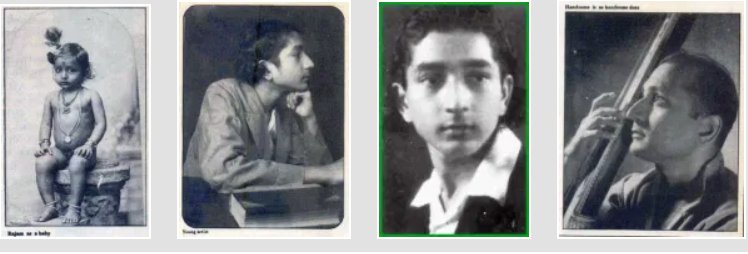
S Rajam was born at Madurai on 10.02.1919
to Parvathiamma (also called Chellammal) and V Sundaram Ayyar, a leading
advocate of Madras. Sundaram Ayyar was a scholar, a person of culture and
a lover of Carnatic music. He,a connoisseur and patron of music, wrote
music reviews for 'The Hindu'; and his views were respected by artistes
such as Ariyakkudi Ramanuja Iyengar and others. S Rajam later in his life
recalled, “In case my father felt that a particular sangati was out of
place, Iyengar would drop it”.
It is said; at the suggestion of
Pudukkottai Dakshinamoorthi Pillai (1875 - 1925), a noted mridangam
and khanjira vidwan of those times, Sundaram Ayyar constructed a
spacious hall on the first floor of his house at Mylapore in order
to hold the concerts of the musicians he admired , such as Ariyakudi
Ramanujam Iyengar, Madurai Mani, Ambi Deekshithar, Muthiah Bagavathar and
Karaikudi Sambasivam. Sundaram Ayyar, it is said, supported and sponsored
a young and talented musician Ramaiya who had come to Madras in seqarch
of a career in music. Ramaiya later flowered and flourished as a noted
singer and a composer of great merit; and gained fame as Papanasam Sivan
(1890 - 1973).
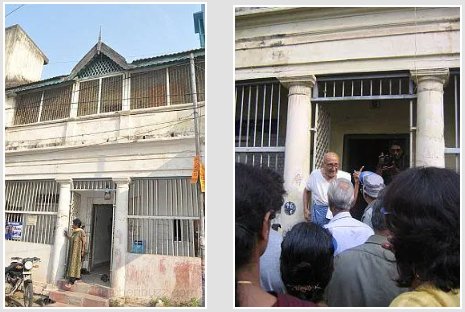
Musicians, writers and scholars frequented
Ayyar’s household which was a sort of cultural hub in Mylapore of those
days. The atmosphere at home was conducive for nurturing love for art and
culture in the young hearts of the children at home. Rajam’s younger brother,
by about eight years, S Balachender (1927-1990) grew into a larger- than
- life personality; a remarkable veena player with a unique style of his
own; a forceful writer; an accomplished actor and an eminent director.
Rajam’s two sisters: Jayalakshmi and Saraswathi too were very good singers.
(Shri VS Gopal who writes and sings delightfully on Sulekha is Saraswathi’s
son. We are in company). Shri Rajam also had a twin bother S Gopalaswamy
and a younger sister , the youngest in the family, S Kalpakam Balakrishnan
. She too was an accomplished veena player.
Rajam had his music training at a
very young age. Sundaram Ayyar had engaged Ramaiya (Papanasam Sivan) to
train Rajam and his sister Jayalakshmi. Rajam was thus the first disciple
of Papanasam Sivan. The talented disciple performed as early as in
his 13th year.
Rajam who was then in P.S. High
School was an avid movie fan; he hardly missed a silent movie that ran
in the tent cinema behind his school. Little did he realize then he himself
would very soon be a movie star. The year 1934 proved to be a very important
year for Rajam a handsome lad of fifteen years; and for his teacher Papanasam
Sivan who in his mid-age (say about 44) was in search of a stable career
in music. The year saw them launched into successful careers in films and
music.
The noted film critique historian
Madabhushi Rangadorai who gained fame under his pen-name Randor Guy has
described the circumstances that led Papanasam Sivan as also Rajam and
family into the world of films. Rajam’s first film was Seetha Kalyanam
(1934), a Prabhat Talkies production directed by the well known Marathi
and Hindi filmmaker of his day, Baburao Phendharkar. The strikingly handsome
fifteen year lad Rajam of sharp features and slim figure played
the leading role of Sri Rama, while his sister Jayalakshmi played the leading-
lady Seetha. (That raised quite a few eyebrows). The film, in a way, was
a family venture, as Rajam’s father Sundaram Ayyar played Janaka, while
Rajam’ s other sister Saraswathi played Urmila and Rajam’s kid-brother
Balachender played a child musician in the court of Demon King Ravana.
The music was provided by Rajam’s teacher Papanasam Sivan.
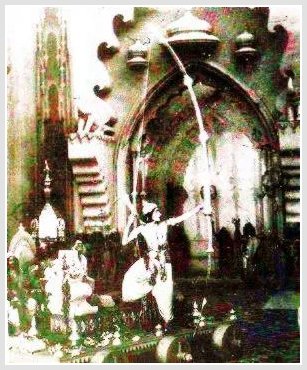
The film Seetha Kalyanam and its
music was a huge success.It launched Rajam and his teacher Papanasam Sivan
on their way to stardom. Some songs set to music by Papanasam Sivan and
sung by Rajam became hits. To mention a couple of those: ‘Nal vidai
thaarum…’ (Raga Kalyani- based on Saint Thyagaraja’s ‘Amma Raavamaa…’);
and, ‘Kaaranam ethu swami….’ (Raga Kaanada -based on Saint Purandaradasa’s
composition ‘Sevaka kana ruchirey...).
Following that success, Rajam’s second
film was Radha Kalyanam (1935), produced by Meenakshi Movies and directed
by C. K. Sathasivan (better known as Saachi). Rajam played the lead role
of Krishna while Radha was played by the beautiful looking star of those
days M.R. Santhanalakshmi who perhaps was elder to the hero Rajam.
The music to the film was provided by the noted singer-composer Sri Harikesanallur
Muthiah Bhagavatar.
Rajam’s third film as hero was Rukmini
Kalyanam (1936); and Rajam played Krishna again. The film was directed
by the famous Marathi filmmaker, actor and Baburao Phendharkar’s brother
Balji Phendharkar.
Of the three films in which Rajam
played the leading role, it appears, the first film Seetha Kalyanam, was
true success; the other two were not so successful. But, by then the handsome
brothers S.Rajam (18) and Balachander (10) had gained fame as 'Prabhat
Prodigy Stars' and 'South Indian Prodigies'. They toured several cities
in India and in Sri Lanka, performing duet-concerts. It is said, like the
legendry Lav and Kush, the two handsome and talented young lads were the
darlings of art-lovers and the cynosure of all eyes.
Shri Rajam played leading roles in
three Tamil films Seetha-kalyanam, Radha-kalyanam and Rukmini-kalyanam;
and also sang. By then Rajam was married and his wife was not in
favor of his acting in movies. Shri Rajam later humorously remarked, all
his three films were Kalyanams and after his own Kalyanam there
could not be any more Kalyanams. Shri Rajam’s association with the world
of films was relatively brief but it was highly successful.
In the years thereafter Shri Rajam
visited many temples in India and Sri Lanka; and stayed for a while in
the 7th century temple of Sri Kailasanathar at Kanchipuram.
Shri Rajam did however later in 1942
played a supporting triple role of Lord Muruga, the boy-Murga, and the
hunter-Muruga in a hit movie Sivakavi in which the doyen of Tamil films
Tyagaraja Bhagavathar the singer- actor played the lead role. Rajam’s sister
Jayalakshmi played the leading lady in the film; while Rajam’s father Sundaram
Ayyar played guru , the teacher of young Sivakavi.
Later in 1948, Shri Rajam composed
music and also sang the song ‘Kaathal puyalthaniley thurumbupol…’ in V.
Shantaram’s ‘Nam Nadu’ the Tamil remake of his Hindi film ‘Apna Desh’.
Shri S Rajam thus was a pioneer in
the development of the Tamil films. Shri Rajam blessed with an agile mind
and good health is today the senior-most living hero, the leading-man,
of the Tamil film world. His contribution to Tamil films is recognized
with pleasure and gratitude.
Music
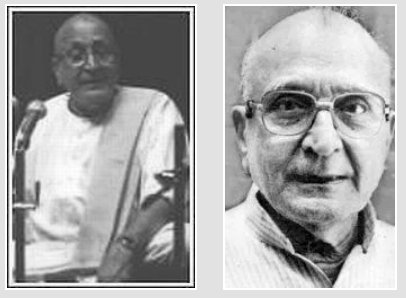
Shri S Rajam is a well recognized,
much admired and an honored performing musician. In his home state, Tamil
Nadu, he enjoys more fame in the world of music than in art. In one of
the interviews to a music journal, Shri Rajam quietly remarked towards
the end of the interview “Not many may know that I am a painter; and I
do original classical paintings. I divide my time between painting and
music.” Such is the humility of the grand-old man of Indian arts and music…!
Shri S Rajam served for about
35 years as music supervisor and a Grade A artiste at the All India Radio
(AIR), where he popularized Carnatic Music and also Thirukkural singing.He
performed full duration kutcheris based on Tirukkural couplets. During
his tenure, he recorded rare compositions of the Vaggeyakars, produced
many operas and musical plays. He later mentioned that His most cherished
program with AIR was the presentation of Silappadikaram as an opera with
a huge orchestra. “Our culture is a very ancient one and we have the responsibility
of passing it on to the next generation in its truest form. I shall strive
to do my best in this regard and may even write a book”.
Between 1970 and 1982, while serving
AIR, he led a team of artists on a music tour to Africa presenting a percussion
ensemble; and toured USA performing 32 musical concerts in various cities.
He also performed in Burma, Sri Lanka and Canada.
His lecture demonstration on rare
Ragas and kritis, vivadi ragas, as also on the compositions of Koteeswara
Iyer are admired by the connoisseurs. His special interest in vivadi ragas
, as also Lakshana and Lakshya aspects of Carnatic music is well
known.
Shri Rajam served on
the expert committee of the Music Academy at Chennai. His simplicity
and willingness to help anyone who approaches him on subjects related to
art and music has endeared him to all and to the young in particular.
Over the years, many honors have
been showered on Shri Rajam. Just to name some of those: He was awarded
the title “Isai Kadal” (ocean of music) by the Tamil Sangham, Karikud in
1988. He was accorded the Sangeetha Nataka Academy award in 1992; and the
Kala Acharya in 1996.
It is interesting that as early as 1947 when Shri Rajam was still a
young man of about 28 years, the late K.V. Ramachandran (well known Art
critic), wrote him: “You know I am not given to praising anyone, still
less over praising. If it were in my gift to give a title, and if any
one deserves it in India today, you deserve the name of Acharya — the
master in painting. I don’t flatter. “Shri Ramachandran (1898-1956) , it
is said , was in his day regarded the foremost music
and art critic in the country. He was not easily pleased; and a
‘good-word’ from him was considered a high reward even by merited
artists. His high praise of Rajam signified the eminence that Shri Rajam
enjoyed even as a young person.
While reminiscenceing his musical
training, Sri Rajam fondly recalls how his father Sundaram Ayyar took him,
while still a lad of ten, to the well known musician Ambi Dikshitar for
music lessons. Talking about his Guru, Shri Rajam mentions that Ambi Dikshitar
had a deep voice of low sruthi that could easily touch the panchama in
the lower octave; and Ambi Dikshitar’s voice was well suited for rendering,
with clarity, the grand and slow paced compositions of Sri Mutthuswami
Dikshitar. Rajam was amused that his teacher a descendant of the Mutthuswami
Dikshitar lineage should commence his lessons with a composition of Sri
Thyagaraja (enta nercina in shuddha dhanyaasi).It was a rare privilege,
he remarked , and a great fortune. Later, of course, Ambi Dikshitar taught
Rajam many compositions of Mutthuswami Dikshitar, most notable being the
navagraha kritis.
He had the privilege of being trained
in music by a galaxy of stalwarts. He recalls with gratitude and pleasure,
“I have undergone training from many Gurus. I learnt Dikshitar kritis from
Ambi Dikshitar. It is from Ariyakudi Ramanuja Iyengar that I attained Pathantara
suddham and perfection in singing fast tempo. I learnt depiction of vakra,
varjya ragas ; and swaraprastara from Madurai Mani Iyer. Papanasam
Sivan though a composer himself taught me lots of Tyagaraja Kritis... Madurai
Mani Iyer taught me Nagumomu with chatusruti dhaivata; while Papanasam
Sivan taught me in suddhadhaivatam, the correct way.... Although I have
learnt from many gurus, I crave to express what we have not heard from
other musicians.”
One of the musicians he admired most
in his youth was Smt. Veena Dhanammal (1867-1938) renowned for adherence
to traditional values and profundity of music expression. He heard her
in the latter years of her life. He spoke of her from his heart
“It was Dhanammal’s music that haunted me in my early years. Dhanammal
was Saraswati incarnate – she sang and played the veena alternately. I
was fortunate to attend her Friday soirees some 40 times. I would sit very
close to her ; and when she sang Akshayalinga vibho, she shed tears while
doing niraval on the line ‘padarivana’. Shouldn’t we have the same intensity
of feeling while performing? How can you be a real singer if you are not
a rasika yourself?”
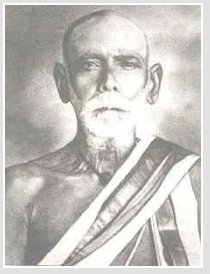
S Rajam’s favourite composer is Koteeswara
Iyer (January 1870 - October 21, 1936) popularly known as Kavi Kunjara
Dasan. “I am deeply interested in Koteeswara Iyer’s compositions ” S Rajam
said,” I do not compare any other composer with him, I find great pleasure
in singing his compositions”. Koteeswara Iyer was the first composer, after
Sri Mutthuswami Dikshitar, who composed krithis in all 72 melakartha ragas.
His monumental work, "kanda ganamudam" has songs, in praise of Lord Muruga,
composed in all the 72 melams. The songs are in chaste Tamil.
Shri S. Rajam has the distinction
of being the only musician to have sung all those 72 compositions; each
krithi being accompanied by raga, neraval and kalpana-swaras. He said,”
It is vital to understand the meaning and bhava of a composition to make
an emotional presentation or render the song with insight “. His rendering
of Koteeswara Iyer’s songs is recorded in a set of ten tapes / nine
CDs . S. Rajam has also published a book giving notations for all the 72
songs.
Music & painting
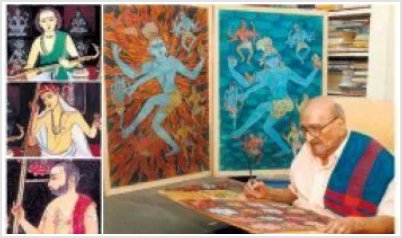
Shri S Rajam is the golden link
between music and art. He provided a visual identity and a tangible idiom
of expression to Indian classical music through his paintings. For instance,
just to mention a few, his series of paintings Origin & Classification
of Swaras (inspired by Sangeetha Kalpadrumam of Harikesanallur Muthaiah
Bhagavatar), illustrating the origins and charectestics of each of the
seven notes of Indian music, explaining their nature and their relation
to the Hindustani and Western music systems, is a remarkable work of great
learning and sublime art. I have not come across a like of it anywhere.
Similarly, his series of twelve paintings
illustrating Venkatamakhi’s melakartha scheme by classifying the 72 mela
ragas into 12 chakrasor segments; associating each chakra with a month
of the year (from April- March) ; and illustrating them through soulful
and imaginative paintings is a marvelous example of the delightful amalgam
of innovation , scholarship and superb artistry. It is a unique piece of
visual poetry and music. This series was also meant as a tribute to Venkatamakhi
the great musician-musicologist (1635-1690).
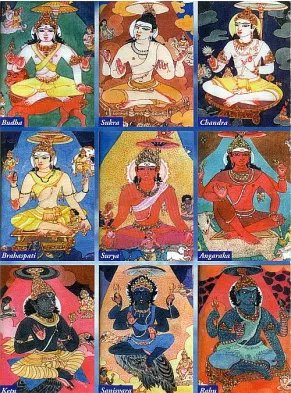
And, his series of paintings illustrating
the kritis and prarticularly the Navagraha kritis of Sri Mutthuswami
Dikshitar are, of course, legendry; and have passed into the folklore of
music, astrology, and tantra traditions and of classical school of painting.
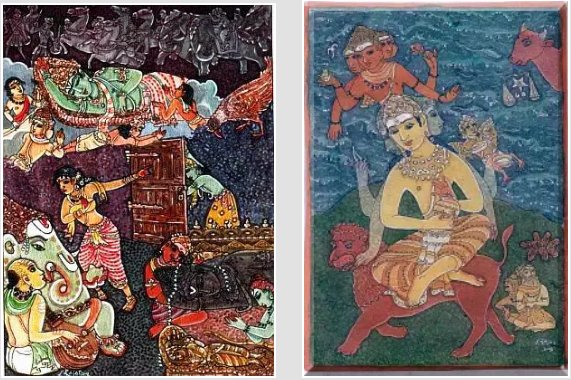
In each case, he poured into puranas,
epics and ancient texts searching for details and for the right idioms
of expression. His involvement was complete; and he was totally absorbed
into his work. While recalling his experience while painting the Navagraha
series, he mentions, “Inexplicable incidents occurred, a reminder that
Dikshitar’s compositions are invested with awesome power. While painting
Surya, gusts of wind would snatch the paper from my hands. Embarking on
Rahu, I found a snake skin hanging from a creeper and even a live snake
coiled beneath the finished painting.”
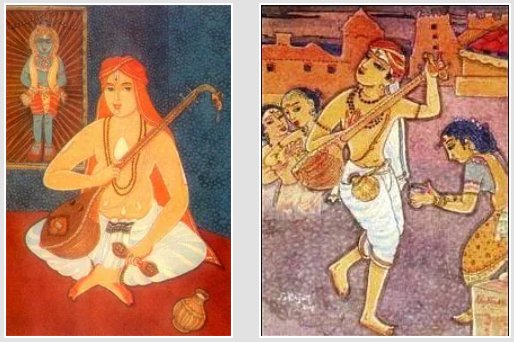
His portraitures of the composers
in the classical traditions of Indian music are benchmarks; and now, after
his advent, one can scarcely visualize the hoary composers but through
the eyes of Shri S Rajam. His portrait of the trinity of Carnatic music
(Saint Thyagaraja, Sri Mutthuswami Dikshitar and Sri Shyama Shastri) which
he painted when he was barely twenty years of age is a true classic; it
is a universally acclaimed archetype and one that is even worshipped.
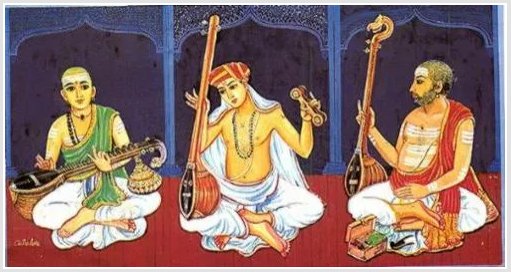
Hallmarks of his portraits are their
authenticity. He studied and researched into his subjects thoroughly, grasped
the essence of their character and achievements. His portraits therefore
bring out not mere the physical resemblance of the subjects but more importantly
the essence of their very inner being.
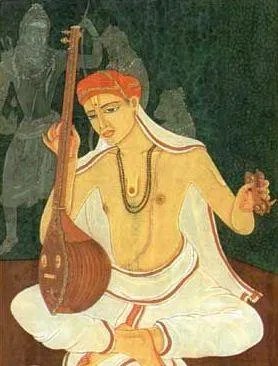
There are some interesting stories
associated with his portraitures of the Music Trinity. In the case of Saint
Thyagaraja, the old drawings available at that time (before 1940) showed
a weak, melancholic person with his chest bones protruding and having a
rather sickly countenance. Shri S Rajam felt offended by the old portraits;
and was hurt the saint was shown in a poor light causing injustice to his
genius. Shri S Rajam strongly felt that the portrait should aptly project
the character and greatness of the person, his achievements, his genius
and his mellow glowing sattvic nature; and not just his physical
resemblance.
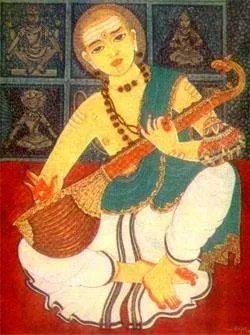
Sri Mutthuswami Dikshitar was an
Upasaka of Sri Chakra and the Devi; he was an advaitin in his outlook.
There was always a certain serene detachment about him; and in his eyes.
In Shri S Rajam’s portraits, Sri Dikshitar comes across as a calm, composed,
handsome young person of lime-color (golden hue) complexion. He always
wears a green (or a blue) shawl over his left shoulder, and sports rudraksha
-mala around his neck. His veena is upturned ; with the face of the yali
looking up.
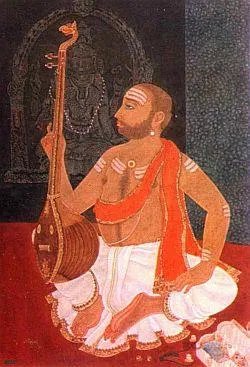
His portrait of Sri Shyama Sastri
which eventually turned into an Indian postal stamp has an interesting
story around it. Sri Shyama Sastri too was a Devi Upasaka, but charged
with intense devotion and a poignant longing for the Mother. He was a deeply
religious person who adhered to the prescriptions of the scriptures. He
always had a dash of vermilion (Devi –prasada) right between his eye brows
and stripes of Vibhuthi across his forehead; he sported a tuft (Kudumi)
and appeared with stuble on his chin because he shaved only once in a fortnight
just as an orthodox Brahmin would do. Shyama Sastri - was a dark, handsome,
serious looking person, rather absorbed in himself and with slight rotund
around his waist. He was always dressed in a gold-laced (zari) dhoti and
a red upper garment (uttariya). He was fond of chewing betel leaf (paan);
his lips are depicted dark red (He is occasionally shown with a paan petti,
a small box to hold leaves and nuts). Shyama Sastri's tambura had a yali-mukham,
not usually found in other tambura depictions.
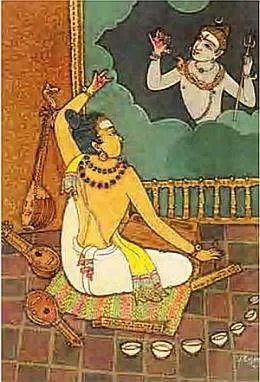
Another interesting incident
came up when Shri Rajam had to paint the picture of Venkatamakhin
[1635-1690 , the great musicologist who devised the melakartha system
of classifying ragas in the Carnatic music] as an introductory painting
for the Apr 2008-March 2009 calendar brought out by L&T, he had no
earlier pictures of Venkatamakhin to guide him. His research into the archives
of Kanci mutt led him to an interesting detail showing that Venkatamakhin
who was also a skillful vainika wore his long hair in a coil such that
it did not touch his body; he coiled it atop his head. Shri S Rajam then
pictured Venkatamakhin with coiled locks of hair, rudraksha-mala; and surrounded
by musical instruments such as veena, tambura etc. as also scrolls of ancient
manuscripts, lending the picture an air scholarship and a spiritual aura.
It is said, nowhere is the bond between
the arts stronger than that binding painting and music.As sister arts,
music and painting share a common vocabulary. Both arts are often referred
to as compositions; both talk in terms of tones and shades; and there is
a certain rhythm and fluency in both. In the present Indian context, nowhere
do both the arts find their fulfillment, in creative as well as traditional
sense, in one person than in Vidvan Shri S Rajam..
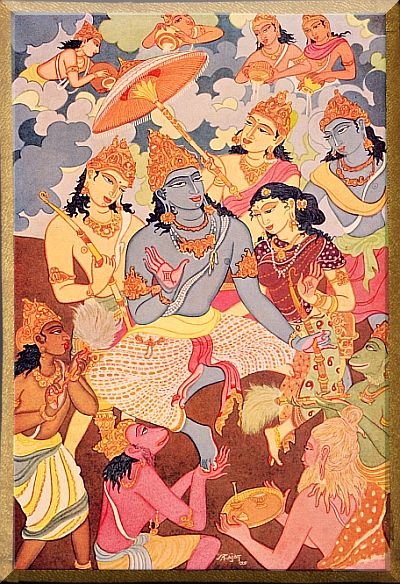
The Chitrasutra of Vishnudharmottara,
an ancient text dated around sixth century AD, states that one needs to
understand music to be a good painter. That might be because the rhythm,
fluidity and grace of music have to be transported to painting, in order
to make the painting come alive and open its heart to the viewer (sah-hrudaya).
That ideal requirement found its fulfillment in Shri S Rajam an eminent
musician who is also blessed with a unique gift of creating sublime art
works. He practiced both the arts with devotion and dedication over long
years of his fruitful life.
I mentioned earlier that Shri S Rajam
has been a true exponent of the Chitrasutra tradition in the modern era.
Let’s get to know a bit more about Shri S.Rajam’s art, mostly through his
own words and pictures; and about his inspiration and guidance...The Chitrasutra.
The Ealy years
Rajam took to art quite early in
his life. By the time he was about fifteen years of age (when he was in
Eighth grade) he was sketching fairly well. His father, Sundaram Ayyar
as also his friends and relatives who too were artists, encouraged Rajam
to hone his skills. He thereafter discontinued formal schooling in his
senior year in High school to join the Government School of Arts and Crafts
in Madras (1935). He appears to have had a great time in the Art School.
He not only had a brilliant academic career but also enjoyed the friendship
and support of his friends and teachers. The Principal was so impressed
by Rajam’s talent,that he allowed the boy to complete the six-year
course in just four years. Later in his life, when he was in his eighties,
Shri Rajam while talking about his technique of water-wash said, “I learnt
it all from my teacher Shri V. Doraisamy Achari ”. Rajam’s Art -
school-mates included KCS Panicker, Dhanapal and Kodur Ramamurthy
who also flowered into great artists.
The quest
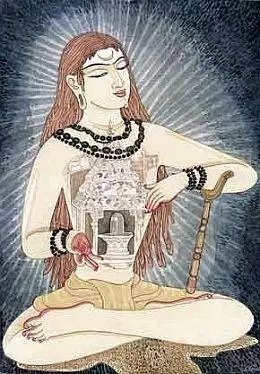
The young Rajam’s visit to the caves
of Ajanta was a turning point in his life; it had a profound effect on
him; and changed his life and artistic career forever. The ancient art
of Ajanta brought about a sea change in Rajam’s outlook of art; his style
of depiction in painting; and his attitude to life in general. He realized,
painting was not just a technique of putting paint over a surface; it was
a way of understanding and expressing your emotions about the life around
you; it was a way of looking beyond the forms and appearances that meet
the eye; and above all, it was about giving expression to a
deeply spiritual experience that springs from the artists very inner being.
The practice of art, he said, was a Sadhana, to be pursued with dedication
and reverence.
The traditional style of the ancient
murals at Ajanta so overwhelmed S Rajam that he suspended
his painting activity for a while and got immersed in search of a style
of his own that would at once be creative, traditional and soulful. He
did eventually, after years of practice, succeed in his search and came
up with a unique style that answered his quest and prayer.
Mr.Lewis Thompson ( 1909-1949)
of England -- a poet turned philosopher and Sanyasin – was also instrumental
in Rajam adopting the Oriental school approach in his painting techniques.
“I owe it to Lewis Thompson who came to Ramana Asrama, where
I used to sing occasionally. He was an English poet, deeply interested
in Indian philosophy, ten years my senior. He used to write his verses
in tiny books. He was responsible for my development and growth in Indian
art. He molded me. He would say, “Art must represent nature, not reproduce
it. That’s why you see that Akbar is bigger than the horse in the miniatures.
Learn perspective but ignore it once you have mastered it.. The size of
the figures depends on their relative importance. “
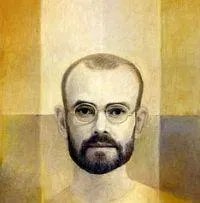
The following is a brief note on
Mr.Thompson.
Lewis Levien Thompson was born on
January 13, 1909 in Fulham, England. He received a good conventional education
in private schools, despite the modest circumstances of his family.
He was a good singer and accomplished pianist. In his teens, Lewis developed
a fascination for the scriptures of the East. He taught himself the Eastern
classics, in translations. He also read extensively in anthropology and
psychoanalysis. He was greatly influenced by the French poet of the symbolist
school Rimbaud (1854-1891) and his wish to discover the soul and the truth.
Like many western intellectuals
of the early twentieth century who travelled East in search of spiritual
wisdom, Lewis Thompson too abandoned his attachments and allegiances; and
plunged into the depths of Eastern philosophy and spirituality. He departed
from England when he was 23 years young (July 26, 1932) and lived in India
for the remaining seventeen years of his short life. While in India, he
wandered the country living off of what others would give him in the form
of food and lodging. Thompson was not interested in finding a guru; but
he came into close contact with various luminaries, including Sri Ramana
Maharishi, Anandamayi Ma, Aurobindo, and Krisha Prem.
During his wandering years in India,
Thompson practiced severe self-discipline of an iterant monk and produced
some hundred-odd poems; an endless stream of aphorisms; maintained journals
over his life in India as a marga, a spiritual discipline; wrote a large
number of letters, and various miscellanea.
On June 19, 1949, Lewis Thompson
was found wandering dazed and penniless by the River Ganges. Taken to a
small room, he languished for two days, writing the last entry in his journal
and his last poem, Black Flower, before lapsing into a coma. He died alone
in Benares on June 21, 1949.
His journal and a collection of
his poems Black Sun were published posthumously during 2001, with an introduction
byRichard Lannoy. Lewis Thompson's work is deeply spiritual, lush with
Hindu imagery; and is sensitive, mystical and erotic. He was later described
as ‘one of the most original, brave, brilliant and prescient of the pioneers
of our contemporary mystical Renaissance’; and,’ as one of the century’s
most intrepid spiritual explorers and a ravishing mystical poet’
It is said; the curious scratch the surface, and, it is only the
resolute that overcome the obstacles and delve deeper into learning of
enduring value. The quest is always more challenging than curiosity but
it surely is rewarding. Shri Rajam’s quest for a unique idiom and a
style of expression took him far and wide into ancient caves and temples
spread across the country and into the study of varied forms of ancient
art-creations, such as the murals, frescos, miniatures, Chola bronzes
etc. He spent week after week in the caves of Ajanta, Ellora,
Amaravathi, Sittannavasal and Sigiriya (Sri Lanka); as also in the
ancient temples of South India and Orissa.
He took thousands of photographs
of the sculptures and the bronzes. He was particularly fascinated by the
three-dimensional comeliness and grace of the bronzes. He poured over his
photographs and turned them into countless sketches and drawings, learning
the art and skill of translating his observation into visual poetry; and
coining fresh idioms, phrases and similes of art-expressions to stamp his
individuality.
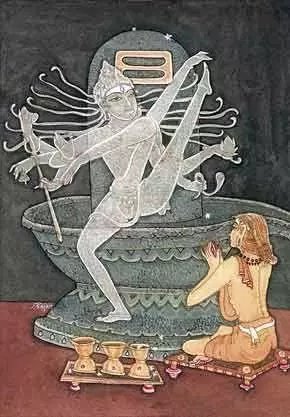
He learnt to visualize his design
clearly before giving it a form. "I contemplate on the photograph
for many days," he says, "and form a clear picture in my mind. Then, much
later, I transfer the image to the surface of the painting”. Thus, imagination,
observation and the expressive force of rhythm became the essential features
of his paintings. Through sustained practice, he learnt to make his pictures
come alive with rhythm and expression.
In addition , he also studied the
ancient texts on painting and sculpture such as the Chitrasutra of Vishnu-dharmottara,
the Kashyapa shilpa sutra etc, along with the epics, puranans and countless
dhyana-shlokas which describe precisely the form , appearance , countenance
, proportions and the nature of each deity. These texts became his guiding
influence; and helped to enhance the authenticity to his depictions.
He also read extensively on the contemporary
art-historians and scholars such as Ananada Coomaraswamy, Stella Kramrisch,
Gopinatha Rao and others. These helped Rajam as an artist to gain a broader
perspective of Indian art.
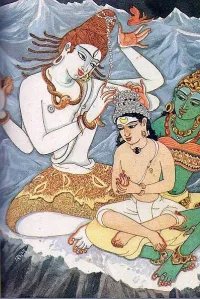
In 1939, Rajam met Sri K.V.Jagannathan – the editor of “Kalaimagal”.
Rajam’s first published work depicting a Guru and his disciple appeared
in Kalaimagal the same year. It was the first of the many that would
follow.
His illustrations on the themes based on literature, mythology and
philosophy became a regular feature in Kalaimagal and other published
works of Sri K.V. Jagannathan. It was a matter of time that his works
were sought by other publications such as Dinamani, Kalki etc. The
special issues like Deepavali Malar gave him ample space to explore his
subjects in depth.
An unusual Maverick
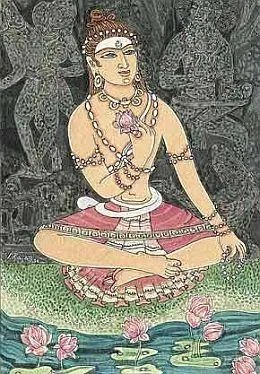
The initial years of Shri S Rajam’s
art-career were stressful; and acceptance did not come easy. He was branded
a maverick, perhaps in the sense that he painted like no one else did.
And, not many shared his philosophical perspective on art. He was criticized,
mostly, for not belonging to a school of painting. But, that did not deter
him in the least. He did not succumb to the trend of the day just for the
whim of it. He was convinced that his style was authentic, creative and
rooted in the tradition of our culture. He asserted he was not a ‘copier’,
but one who painted in his own way. He said, “My art is in representing
nature and not in reproducing it”. It is our fortune Shri Rajam stood
his ground. Since then, he has been composing his own one-of-a-kind masterpieces
for more than six decades. And, today his classical genius is not
merely well accepted but revered as an icon of creativity and grace rich
in tradition.
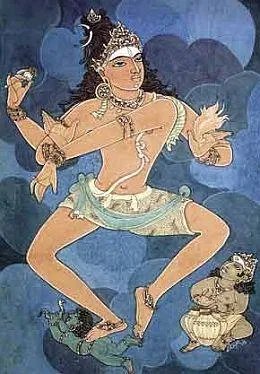
Even so, Shri Rajam is disappointed
with the drift of the times. "Hindu heritage and tradition is ancient and
priceless," he laments, "but devotional art is dying in India and almost
extinct. Unfortunately, we Indians ape the Westerners. This attitude wounds
me a lot. In tradition, only good things should remain; the bad should
be ignored and not continued. This is tradition. The art schools in India
have failed to bring forward tradition…., Artistic creation is lacking
in arts schools. The training imparted is purely technique oriented, and
this by itself is not of much use."
His message to the young and budding
artists of India is this: "Study scriptures to improve your knowledge.
Be modern; there is no problem with that. But know the beauty and elegance
of your culture."
Shri Rajam’s art and the Chitrasutra
Outlook
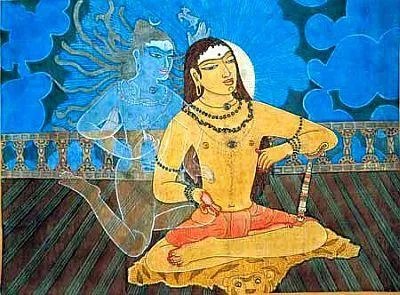
While talking about his approach
to art, Shri Rajam said,” my art is not, nor was it ever meant
to be, realistic or photo-like replicas of life, but rather intuitive perception
of life”. He asserts that in his paintings and line drawings, he attempts
to imprison the important moments of the subject’s life to help the contemplative
spirit of the observer. His pictures might depict the resemblance but,
more importantly, as he said, they aim to bring out the essence or the
soul of the subject.
When Shri Rajam said that, he was
not merely making a statement but also was echoing the prescriptions of
the Chitrasutra which stressed that the concern of the artist should not
be to just faithfully reproduce the forms around him. The artist should
try to look beyond the tangible world; and beyond the beauty of form that
meets the eye. He should lift that veil and look within. The Chitrasutra
suggested, the artist should look beyond “The phenomenal world of separated
beings and objects that blind s the vision of the reality”.
The Chitrasutra emphasizes that art
expression is not about how the world appears to one and all, but how the
artist would experience and visualize it. Art is an expression of his unique
creative genius, imagination, enterprise and individuality as an artist.
Its purpose is to present that which is within us; and to evoke an emotional
response (the rasa) in the viewer’s heart.
Shri Rajam’s art creations are excellent
illustrations of these principles of the Chitrasutra in the modern times.
In his mission, Shri Rajam followed the approach of the classical Indian
Art rather that of the west where art directly reproduces the nature and
its physical form as it appears to one and all.
Abstract & Symbolism
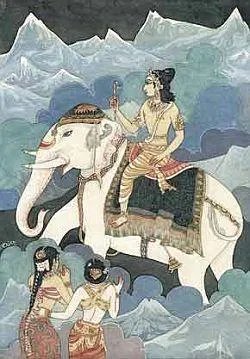
While explaining the special features
of traditional Indian art, Shri Rajam in his interviews and articles stresses
the point that the traditional Indian art relies more on symbolism than
on realism. He says, an artist’s power arises from observation translated
into visual poetry through similes and suggestions. The eloquent expression
of a painting, that is, its Bhava, according to him,consists in drawing
out the inner world of the subject. It takes a combination of many factors
to articulate the Bhava of a painting; say , through eyes, facial expression,
stance , gestures by hands and limbs, surrounding nature, animals , birds
and other human figures. Even the rocks, water places and plants (dead
or dying or blooming or laden) can be employed to bring out the Bhava.
These aspects gain greater importance in narrative paintings, which demand
special skills to depict the dramatic effects and reactions of the characters,
in its progression from frame to frame.
The concept of the abstract and
with it a whole set of symbols and symbolisms, that Shri Rajam was discussing,
were also the concern of the Chitrasutra. The text suggested the means
to render the absolute and the undefined into tangible visual forms.
It said, the objects in nature could be visualized or personified endowing
each with a distinct personality in order to illustrate the essence of
their character. Accordingly, in the traditional Indian art, the elements
of natures like rivers, sun, moon etc were personified, bringing
out their virtues and powers through eloquent symbolisms. Birds and
flowers, trees and creepers too were depicted with a loving grace and tenderness.
In certain cases, idyllic nature scenes were created just to convey a sense
of joy and wonder.
Shri Rajam’s art abounds in such
symbolisms.
The preparation
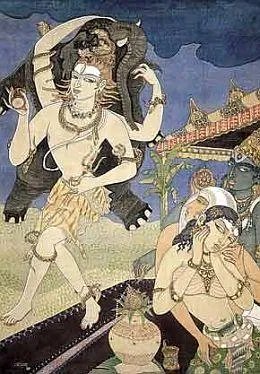
Shri Rajam talks about the way he
prepares before commencing on a painting. It is highly interesting. His
approach is methodic, thorough and a classic example for others to follow.
He studies every available material about the subject, such as the epics,
scriptures, the legends; and, archived documents, earlier paintings and
photographs in case of personalities. He visualizes his design, contemplates
on it and lets it sink into him. He explains “The subject should be visualized
with absolute clarity in the mind’s eye, before setting pencil to paper.
I let the preliminary sketch ‘sit’ for a few days, then review, making
corrections and changes. Initially I color the background using a soft
wash technique originating from the Santhiniketan School, a special feature
in all my paintings. Then I define the main figure through light and shade,
with highlights in white. I aim to bring out the grace of the human form
and poses, for example tribhanga, with the drapery serving to accentuate
form as exemplified in Buddhist sculpture.”
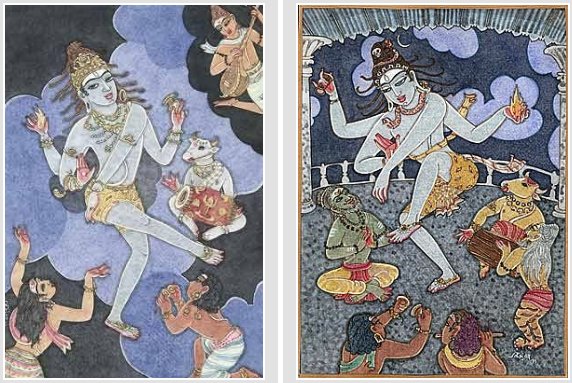
Even to this day, after nearly seventy
years of painting, Shri Rajam visualizes his design after careful study
and research into the subject; and only then attempts to draw. He says,
"I form a clear picture in my mind. Then, much later, I transfer the image
to the surface of the painting."
Rekhas, the lines
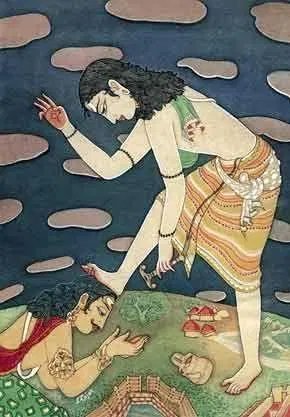
The Chitrasutra regards the lines
–Rekhas- that articulate the form of the figures as the real strength and
virtue of a painting; and the ornamentation and coloring as its decorative
aspects. Chitrasutra favors employing the graceful, steady, smooth and
free flowing lines. The Chitrasutra does not favor straight or harsh or
angular or uneven lines. Its masters valued the effects best captured by
least number of lines. The economy of lines and simplicity of expression
were regarded as the sign of the artist’s maturity.
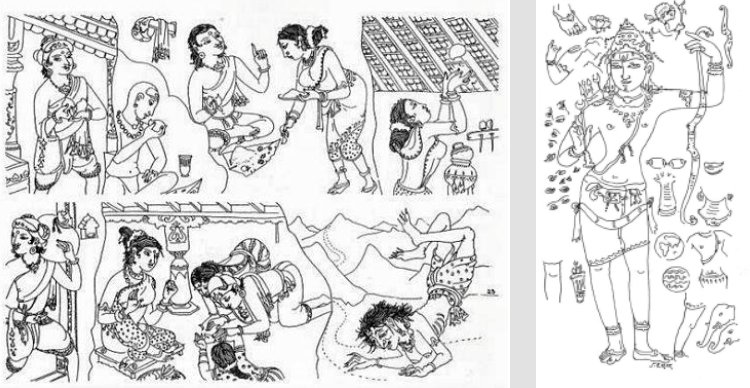
These too are the characteristics
of Shri Rajam’s paintings. The first thing you notice in his works
is the strength of the lines that defines precisely the form of the figure.
He says, “The line is the life of a painting. I developed my own style,
taking from the model of our ancient culture.” He explains that in the
oriental traditions, the lines – the Rekhas- are of prime importance unlike
in an oil painting. It is the lines that define the substance and form
of an oriental painting. He describes his style as closest to Shantiniketan
style, emphasizing the lasya –lyrical –aspects.
[ The Shantiniketan School of art,
sphere headed by the renowned artist Abanindranath Tagore, was a revivalist
movement that was strated by around 1905. It strived to revive the traditional
Indian techniques of art and art styles, deriving inspiration, mainly,
from the murals of Ajanta. Its style was, basically, a refined and harmonious
blending of simple beauty of expression brought to life by graceful lines
and an essential Indianness. The Shantiniketan art done mostly in watercolors
depicted Indian religious, mythological, historical and literary subjects.
Its style, endowed with the beauty and vigor of its lines, sense of proportion,
grace and charm soon became an authentic idiom of Indian art expression.
Shri S Rajam derived inspiration
from this tradition too. ]
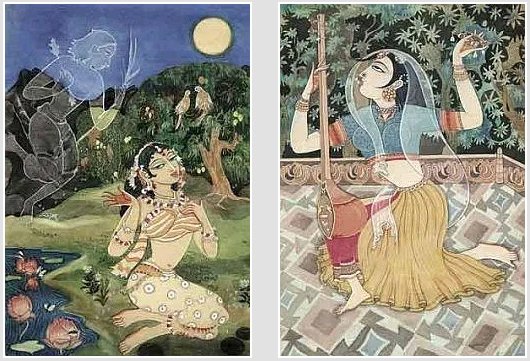
The lasya - the lyrical - aspect
which Shri Rajam was talking about refers to delineating beautiful figures
and their delicate inner feelings through graceful, steady, smooth and
free flowing lines that capture their essence . His line-drawings are full
of grace and vitality. The delicate touches and intimate details that he
deftly adds, enliven his figures.
Following the tradition of the Chitrasutra , Shri Rajam has depicted
nature as in summer; Rainy season; Autumn ; early winter ; and, winter :
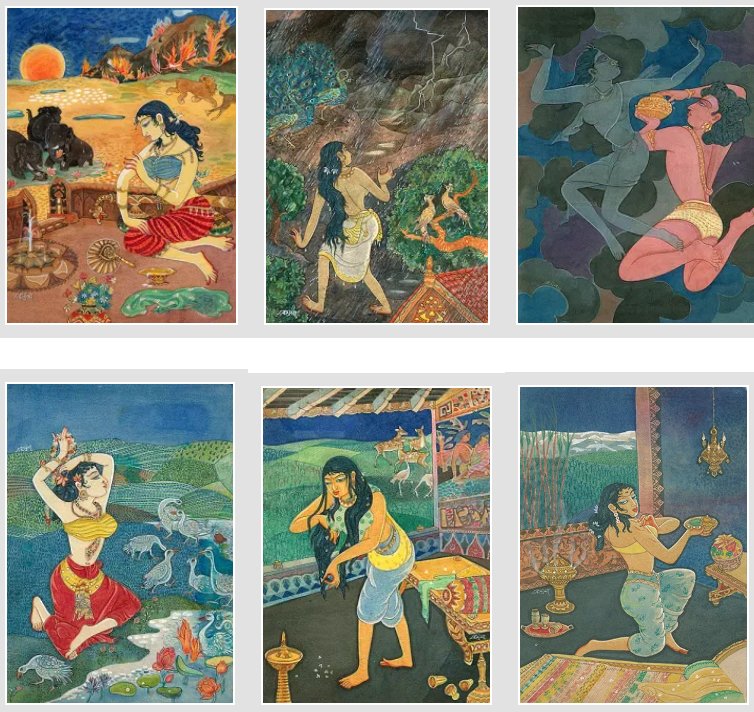
Shri Rajam has also sketched some rather ‘non-traditional’paintings :
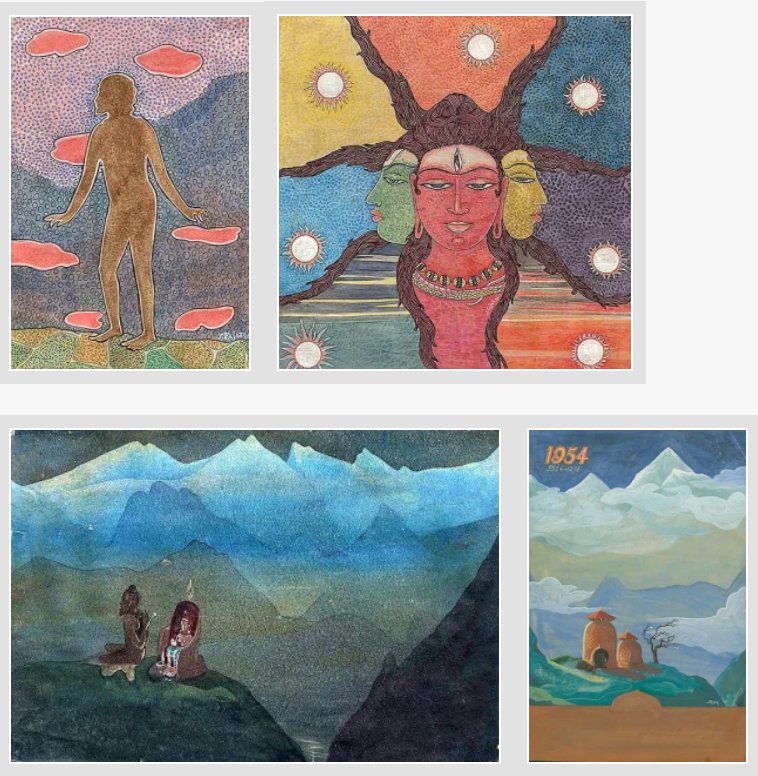 Simplicity which is natural and
pleasing
Simplicity which is natural and
pleasing
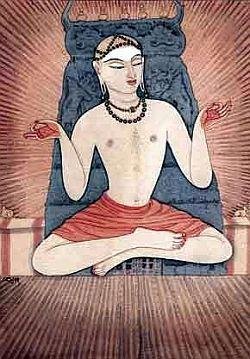
Shri Rajam says, he aims to infuse
into his paintings a simplicity which is natural and pleasing. He stresses
the economy of lines and simplicity of form as central to his approach.
It is upon this background, he says, he is able to introduce “personal
innovations” into his works. That is the reason; his paintings are a rare
blend of traditional styles with his unique touch.
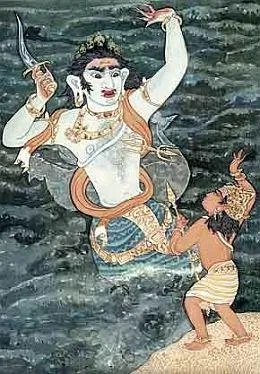
It is because of that approach you
find a natural quality and grace in Shri Rajam’s paintings; they almost
seem effortless. The vigor, the strength and the power of a heroic figure
are brought to life by the vitality of its lines; not by his fat muscles
or his sheer size. With use of shading different parts of the body, it
produces three dimensional effects in the images. Even the demons
in his paintings are never muscular or excessively fat. The outlines are
strong and very sure; and there is an easy and natural depiction of volume,
evidencing a good understanding of the rhythm and the structure of the
human body.
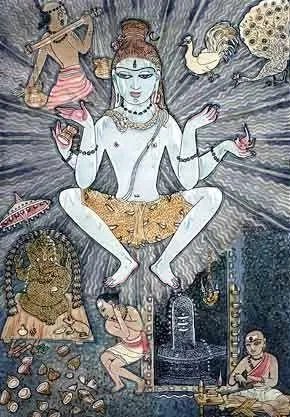
His figures are never rigid and static.
Their stances are always suggestive of flowing movements of languid grace
and charming rhythm. Their distinctive display of smooth motion and the
sense of balance are lovely. The painted figures of the “heroes” present
a profound sense of peace and joy even while placed amidst activities and
contradictions of life
Shri Rajam’s works are excellent
illustrations of the principles and aspirations of Chitrasutra.
Colors
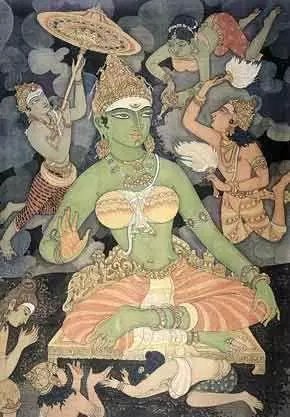
Another distinctive feature of shri
Rajam’s works is the use of soft color schemes, uniquely decorated costumes;
and delicate, deft cultural "touches" that lend authenticity to the context,
period and the status / nature of the subject. He often lets elements drift
partially off the canvas. But above all else, there is a flow of curve
in all of his designs that projects a certain distinctive grace of smooth
motion even in stillness.
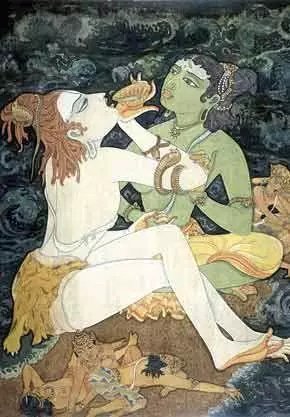
The other is the use of proper colors:
soft and subdued, the lines firm and sinuous and the expressions true to
life. The colors, at times contrasting and at times matching are artistically
employed to create magical effects. That effect is enhanced by the skillful
shading of the body-parts, giving them a three dimensional appearance;
and providing depth to the picture. These were precisely the principles
that Chitrasutra too recommended.
The Chitrasutra aptly remarks, when
a learned and skilled artist paints with golden color, with articulate
and yet very soft lines with distinct and well arranged garments; and graced
with beauty, proportion, rhythm and inspiration, then the painting would
truly be beautiful.
How very true that is in the case
of Shri Rajam..!.
Eyes
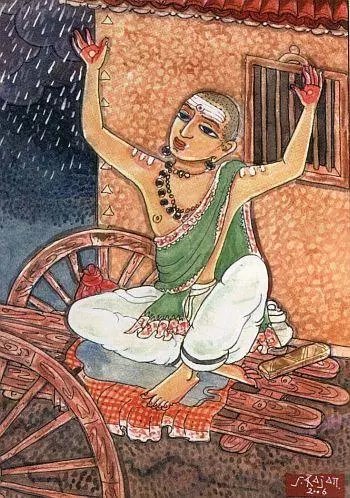
The Chitrasutra tradition regarded
the eyes as the windows to the soul. And, it said, it is through their
expressive eyes the figures in the painting open up their heart and speak
eloquently to the viewer. It therefore accorded enormous importance to
the delicate painting of the soulful and expressive eyes that pour out
the essence of the subject. The lively sets of lustrous pools of eyes continue
to influence generations of Indian artists; those eyes are, in fact, a
hall mark of Indian art works.
One finds a vindication of these
principles in Shri Rajam’s paintings.
Gods & Goddesses
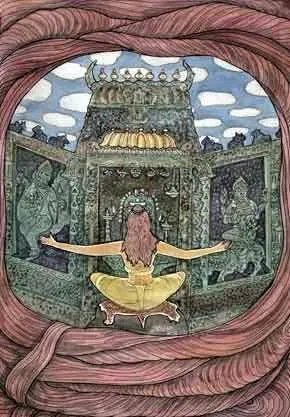
A lot of figures depicted by Shri
S Rajam are of gods, goddesses, sages and demons; as also of the kings,
queens and the composers of the bygone eras. His involvement in their creation
was total; he not merely researched into their every available detail but
also tried to get into their spirit. "Practically speaking, to paint the
Gods and Goddesses, you must imagine them aggressively," says Rajam “There
are rigid rules of grammar regarding proportions. Yet, the artist has to
assume the freedom to compose his picture according to his aesthetic sense.
There may not be a physical resemblance to the subject; but one should
surely try to bring out the essential nature of its character.”
You will, therefore, find in Shri
Rajam’s paintings the virtues and powers of the gods and demons made explicit
by employing varieties of forms, symbols and abstract visualizations. That
artistic liberty, freedom and felicity of expression is a characteristic
of classical Indian art, as also of Shri Rajam’s art. He quotes the
text (Chitrasutra) and says, “Rules do not make the painting; it is the
artist with a soul and vision who creates the art expressions”.
Many of his creations have now turned
into objects of worship; and adorn the walls of the temples and pooja-rooms.
That might be because, Shri Rajam’s art awakens the divine presence within
us; and we respond to the sublime images brought to us in his art. When
that happens, we are filled by grace and there is no space left for base
desires and pain: we have become that deity.
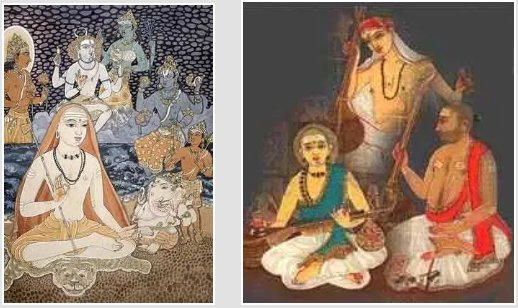
Shri Rajam’s art has that magical
quality, which brings out the essence of life and the grace that permeate
the whole of existence.
Secular art
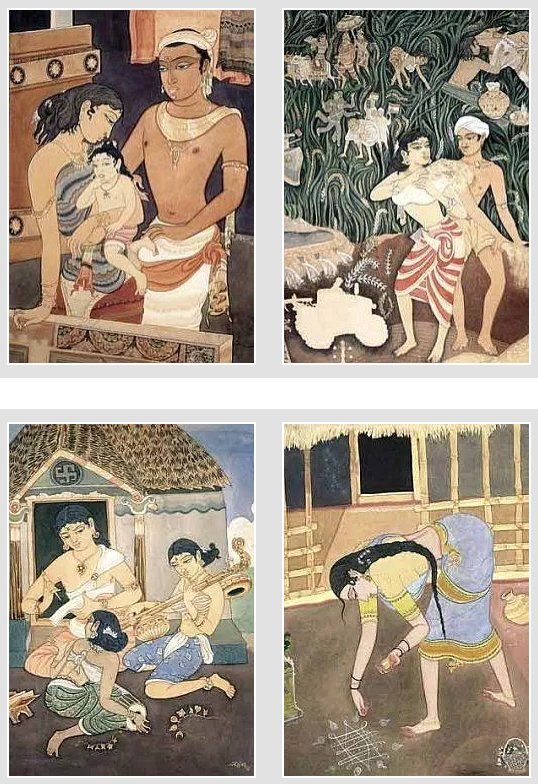
Even his secular art is rich in
expressive realism, reminiscent of the paintings at Ajanta, Bagh and Sittannavasal.
They testify to his love of naturalism - in the depiction of the human
form and in the depiction of nature. Yet, his pictures always seem
to suggest to something beyond the obvious, stimulating the senses and
igniting the imagination of the viewer.
The technique
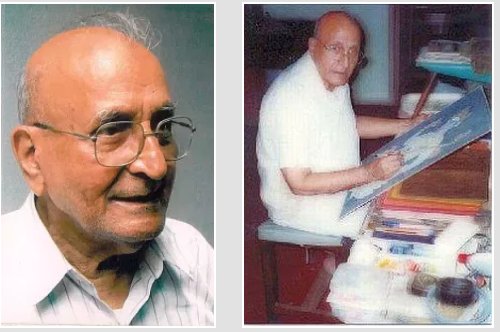
Shri Rajam says, he first paints
the outlines , then colors and goes on to finish with lines.
His themes often required meticulous research. After research, he
created the entire painting with the all details in his mind. He started
off the paintings with a pencil outline depicting the central figure.
The actual painting is done around this central figure thereby creating
the required depth.
The medium used by Shri Rajam is
watercolor on cured plywood, veneer, handmade paper and silk (not the mulberry
silk but the tussar silk, the non- violent silk, at the suggestion of The
Paramacharya of Kanchi). It is said that in his earlier days Shri Rajam
made the paper himself. As regards silk, he says one has to be very careful
while painting on silk, because mistakes and wrong lines cannot be corrected
or erased easily.
He used layers of transparent colors. Each color is applied only to be
washed away with water using a brush. Upon drying the next layer is
applied and washed away. It is this series of washes and the combination
of the colors that eventually gave the desired color scheming that was
originally envisioned. After the application of the transparent colors,
the opaque colors are applied over it. Finally, his characteristic ink
outlines (rekhas) were done using a Fine liner pen.
Each painting of his will have about
25 layers of color; and will be washed ten to twelve times before it is
completed. His technique involves washing the paper by dipping the brush
in plain water and dabbing it all over the painting. This he does every
time after applying a couple of layers of color. "Do you know why I do
it," he asks. "It is to remove the excess colors from the painting. Only
the subtle brush strokes and effects remain and all that is garish is washed
away. Do you know I lose more than 30 per cent of the paints this way?
It is a loss. But my painting will survive without problems and its life
will be as long as the medium on which I do it”.
Shri Rajam calls this process “water-wash”,
which according to him is an oriental technique, unique to Indian and Chinese
painting. The Chinese method, he says, is also the same but the number
of washes is not as many as in the Indian method. He explains, “A
wonderful quality of this oriental wash technique is that the painting
can be washed in water and no colors will come off except the final touches
of tempura colors “.
He says, such repeated washing –treatment
helps the color stay on the surface and last longer, because through the
process, all the colors are absorbed by the handmade paper on which the
pictures are painted. Luckily, the handmade, rag paper etc. that
he uses can withstand his water-wash treatment. Not only that, strangely
the paintings do not smudge and they emerge all the more beautiful after
being subjected to water- wash.
He uses transparent watercolor while
building the layers, and applies opaque colors in the final stages of highlighting
and finishing. As colors are applied from light to dark, it enables the
undertones of previous colors to be visible. This gives, according to him,
a misty and toned effect suitable to portray the imaginative subjects.
The process is laborious and takes
nearly ten washes and about a week to ten days to finish a painting. But,
he says, it worth doing it because the method ensures that colors last
longer and stay bright. And, even in case the painting gets wet, the colors
remain unaffected.
Clearly, this technique requires immense patience and (depending on the
size) each painting can take from a few weeks to a few months for
completion. It was Rajam’s disciplined approach and incredible ability
to multitask that allowed him to simultaneously work on several
paintings. It was his capacity to quickly mentally switch from one theme
to the other, as the paintings were drying, was the main reason for the
volume of work he could produce.
Shri Rajam recommends that the watercolors
be preserved behind glass and ensured that no fungus develops between the
painting and the glass.
Phenomenal output
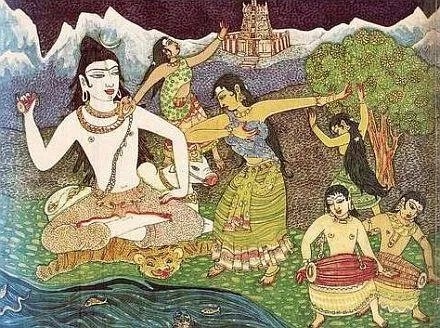
Considering the volume of study,
research and work involved; and the time taken to complete a painting,
the prodigious output of Shri Rajam is totally amazing. For this scholarly-painter
phenomenon who has entered his nineties, his work is his worship. His zest
for work is enormous; and says he is "just beginning”. Even at his age,
he is as inspired and enthusiastic about his work as he was in 1940 when
he took to painting seriously; and he is no less prolific. Shri Rajam now
in his nineties paints for about three to four hours every day. Art
and music are his passions and they keep him young.
His art work has adorned several books .The paintings produced by
him over the years, I reckon, run into a few thousands. I am not sure
whether either Shri Rajam or anyone else has kept a count of his
artistic output. Some of his works have also been compiled as
books. Notable ones are the Chitra Periya Purana – depicting the legends
of the 63 Nayanmars and the Thiruvilaiyadal Puranam – depicting the 64
divine plays of Shiva. Another book titled “Dancing with Shiva”
published by the Himalayan Academy, Hawaii , USA has over 300 hundred
works of Rajam reproduced with exemplary production value.
(Visit
HimalayanAcademy.com)
It is said , the Himalayan Academy Publications has scanned 923 of Shri Rajam’s creations.
There have not been many formal exhibition
of Sri. S. Rajam's works either, except perhaps the one held in Los Alamos,
NM, USA in 1981.
The arrays of subjects chosen by
him are vast and diverse. They range from the gods, goddesses, demons,
Vedic sages, characters from puranas, literature, history, planetary deities,
music composers, Nayanmars , Thirthankaras and Acharyas of various
periods and inclinations ; festivals , fine arts folk arts and so
on and on.
His works are distributed over book-
covers, countless magazines published in various languages, book illustrations,
compilations, chronicles, life histories etc. Yet, he feels he has not
done quite enough and could have done more; "There is so much more I can
do” he rues even at ninety.
Anyone, even vaguely familiar
with his paintings cannot help but wonder how a person, amidst his various
interests , pursuits and preoccupations in life, could achieve so much
in various other fields of his activities and yet produce countless
sublime and soulful precious works of art .. And, all that in one
life time…!
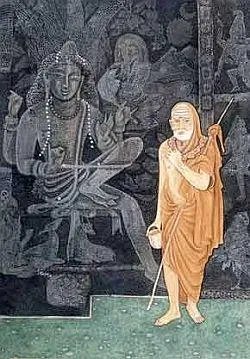
That is the genius called Acharya
Shri S Rajam, the very incarnation of the Vedic seers he admires and adores.